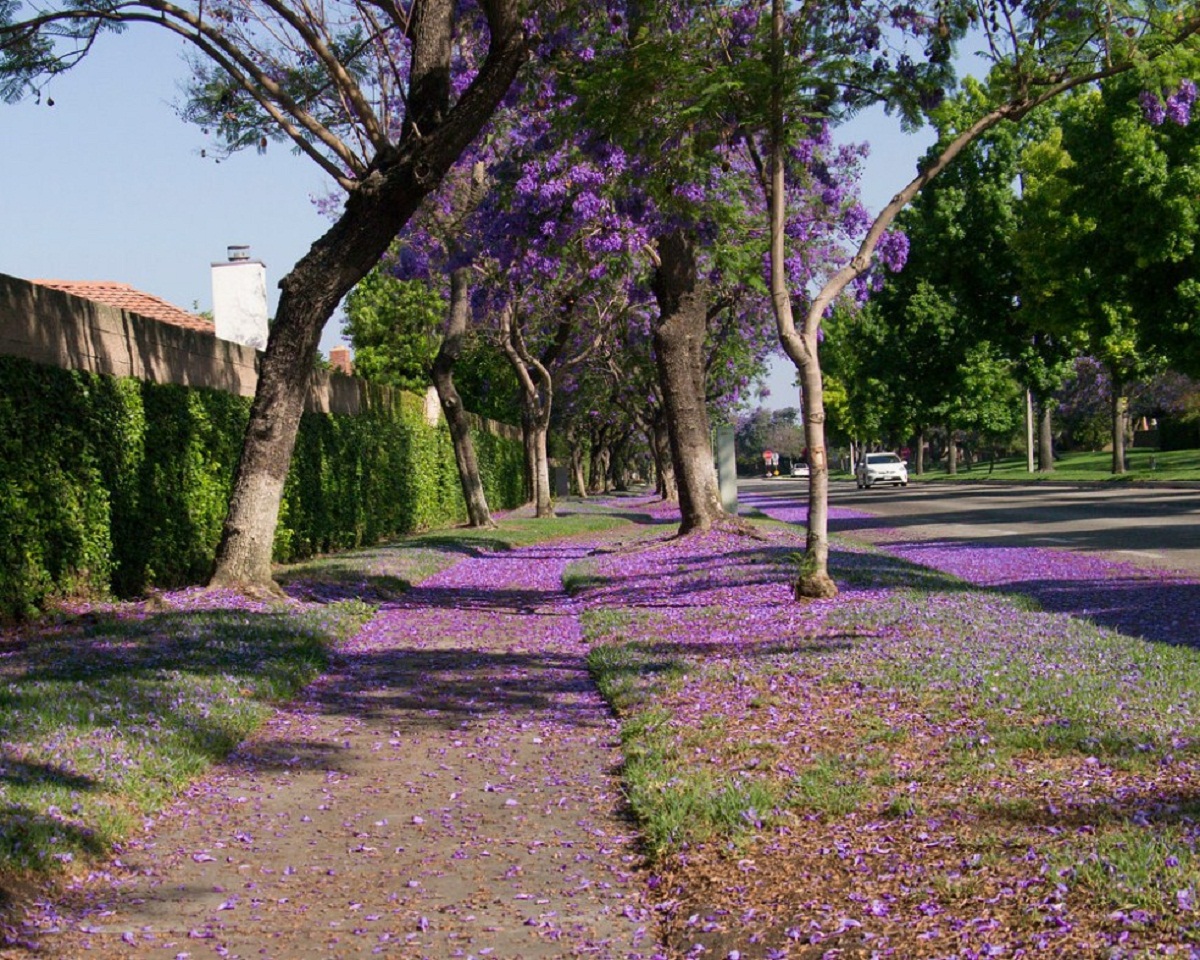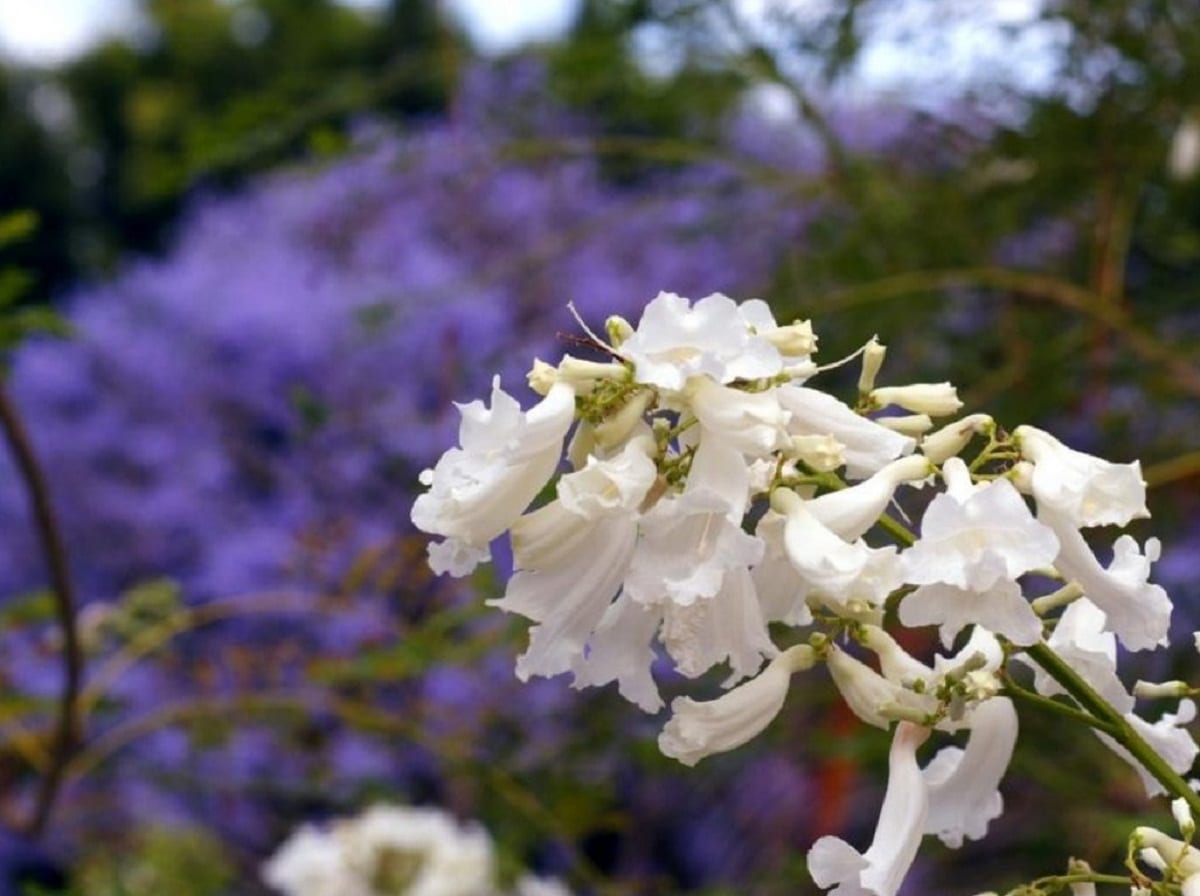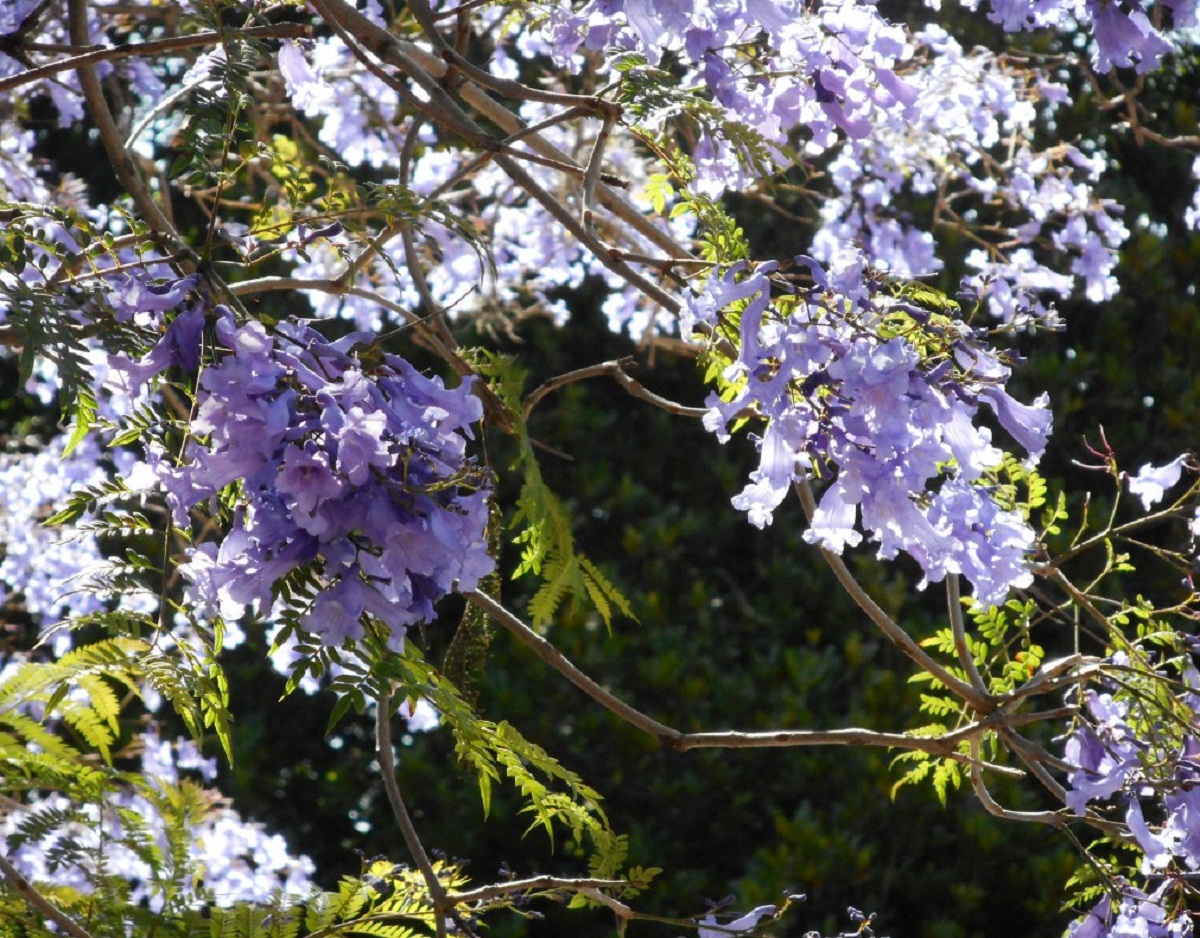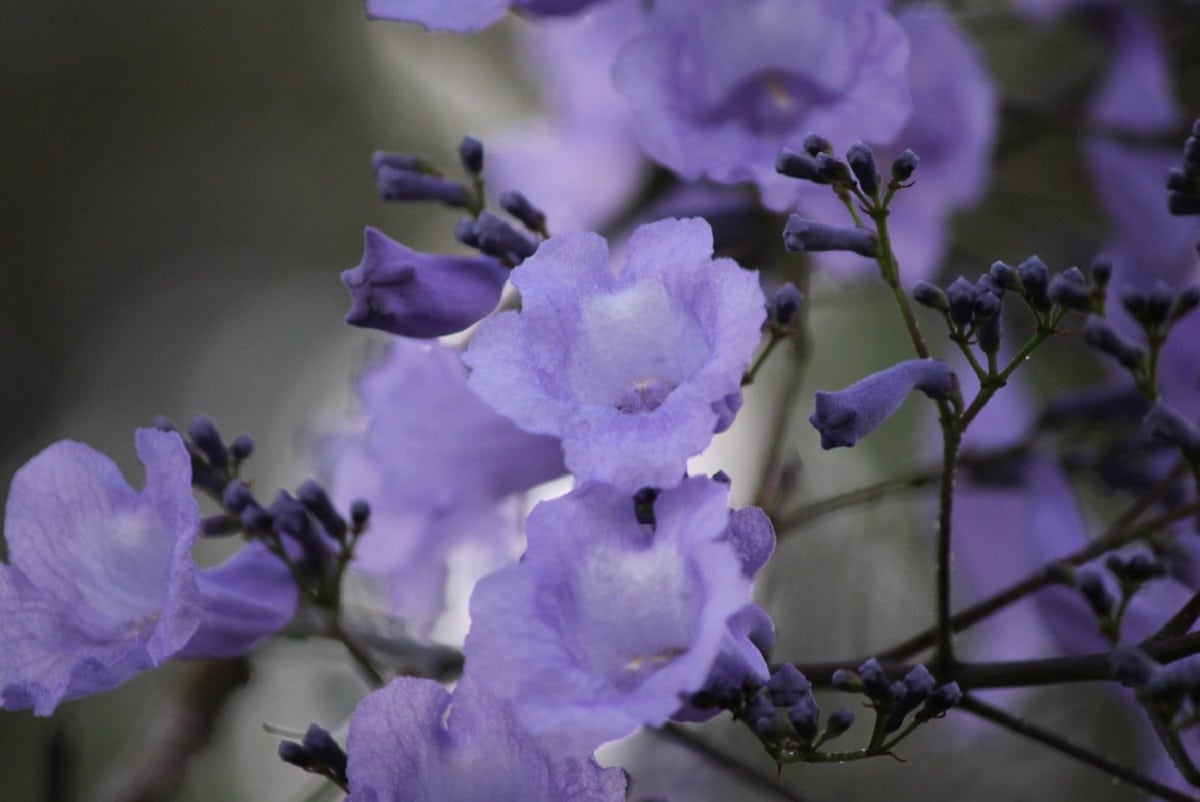
Can you imagine being able to enjoy a walk among beautiful examples of Jacaranda? This species is so grateful and ornamental, that many of us had enough to look at it once to be fascinated ... or am I wrong?
Surely you have seen this plant in many photos on social networks without knowing that it was the Jacaranda. But what is more common, you came to think that the photo was a montage and that a plant could not have a purple color as vivid as that of this species.
Discover everything you need to be an exceptional garden tree
But, before getting into the subject, let me tell you something ... If you like the Jacaranda with lilac flower, this one with white flower will make you fall in love. Sight:

Its flowers are beautiful! And it needs the same care as the lilac flower. What are they? These that I am going to tell you now. You will be surprised how easy it is to take care of it.
Origin of the Jacaranda
Despite having characteristics of an Asian species and / or plant, the Jacaranda is native to tropical areas, such as those you can find in South America. Being more specific, It is common to see Jacaranda in countries such as Bolivia, Paraguay, Argentina and areas that share similar climates.
A fact that very few know is that the plant originally resides in Argentina, Paraguay and Bolivia. But as such, this particular species (jacaranda mimosifolia) has its place of origin in the Tucumano jungle, located in Bolivia.
The Jacaranda is a plant whose flowers have a similar appearance to a bell or trumpet. If you don't believe it, you can check other plants on our website that belong to the same family and notice that similar characteristic.
Places where you can closely appreciate the beauty of this plant can be in places such as María Luisa Park, in various parts of Seville, some streets of Santa Lucia in Tenerife, etc. And the reason why this plant is used is simply to color the site and make it more striking, either for tourists or residents of the place.
Although, if you ask yourself, what reason would you have for not planting this species in your garden or making a path with Jacaranda? After a few years, you will have a movie atmosphere and this is not a joke.
On the other hand and as a curious fact, there are around 50 species of Jacaranda officially registered. So you could have one near your house and not know it. But thanks to the characteristics that we will name you shortly, you will know what one of these plants looks like.
Features

The Jacaranda is a rather medium-fast growing tree, although without being fast. It grows to a height of about 10 meters, although in cultivation it rarely exceeds 6m. Its crown gives very good shade, since it can reach 3m in diameter and its leaves remain on the plant, but in cool climates it will lose them totally or partially.
As for its bark, it tends to acquire a crooked shape and the texture is cracked, so it is common for it to acquire a corky appearance. And if you look closely you will see that the cracks are quite deep compared to other plants with similar characteristics in their bark.
Moving on to what its leaves, sadly it is a plant with deciduous foliage. That is, when it reaches a certain time of maturity, it loses absolutely all its leaves. But this is not a problem. The loss of its leaves does so at a fairly slow rate.
It is easy to find Jacarandas whose crown is shaped like an umbrella, some tend to be semi rounded or have no shape, or even find specimens that acquire the shape of a pyramid.
Regarding the general structure of its branches, it tends to create several completely irregular branches, and depending on its branches, it will acquire different shapes from each other. Something curious is that this plant has a life time of more than 100 years, so you can enjoy the beautiful color for quite a long time.
Now, the flowering of this plant occurs mostly during spring, but there are cases where flowering can also occur during the summer or early fall. This change of time in terms of its flowering will depend on the environmental factor.
Don't worry, it seems strange to many that this plant, in addition to creating flowers, also produces fruits. But yes, it does. The Jacaranda fruit has a capsule appearance and its size is between 6 and 8 cm., and the color of these capsules is brownish green.
The number of seeds for each capsule is numerous and these come to measure around 2 cm in diameter. Taking into account its characteristics, the ideal is to plant it in an area exposed directly to the sun, protected from intense air currents.
I recommend putting it away from the pool, since although it is a tree whose leaves and fruits can be easily removed without leaving a trace, in climates that are not tropical we may be forced to constantly remove them from the water.
Care
This plant requires special treatment when it is just developing. This treatment depends on the season and the amount of fertilizer to use. That is to say, while the Jacaranda is hardly growing, compost should be used during the summer and spring.
To be more exact, about 25 cm of natural compost should be used. Afterwards and when the plant has acquired sufficient size, the quantity and number of times will decrease.
Now, you may wonder how the Jacaranda can get a shape like the pyramid. Everything is in how the plant is pruned. If you want the plant to grow and acquire a special shape, we recommend that you opt for pruning as long as you do it in autumn, and it is really necessary.
And if you look at all the photos of Jacarandá that you will find on the internet, you will notice that the plant is always outdoors, surrounded by specimens of the same species but above all, located in a place where they receive direct sunlight.
To finish this section, irrigation should change as it grows. Once it has reached its final development, watering should be regular. The correct way is to avoid puddles as usual and give the plant an efficient drainage system.
Withstands temperatures down to 3 degrees below zeroBut once the mercury in the thermometer stays low ... growth stops. Thus, the water needs decrease.
For the rest, it is a tree that can grow in all types of terrain, especially if during the entire growing season (from spring to autumn) we periodically fertilize it with natural fertilizers or liquid fertilizers.
Diseases and pests
It is true that the plant is a beautiful eye-catching species and that it is worth having anywhere. But like any plant, is prone to diseases and / or pestsBut the good news is that it is very resistant to these problems, so this is usually not a big problem.
What if this particular species can suffer from aphids, thrips and other annoying insects. And although this is not usually a major problem, there will be times where the plant ends up suffering from Jacaranda disease, which is nothing more than a bacterial infection that is lethal for the species.
If the right amount of water and fertilizer is not provided, the health of the plant is likely to decline, and even worse if it is not provided potassium soap in case of problems with aphids or thrips.
Uses

This plant not only has a decorative use in natural parks, gardens, roads, streets and others, but it also has other very interesting uses. For instance, Jacaranda flowers are used to make wines, various types of liqueurs and even honey and syrup. And if you wonder, yes, perfume is also made from Jacaranda flowers.
But this not this, since also can be used to create natural walls and decorate them at the same time. This would be a long-term use, but in the same way, it is a viable option if you want to have a natural space but above all it has a pleasant smell thanks to its flowers.
For the rest, the Jacaranda is basically marketed and used to decorate urban spaces. The reason is that both the aroma and the color of the plant and its flowers have a positive psychological effect on people.
How are the roots? I don't have a farm, but I have a patio.
Hi Heidie.
Jacaranda roots can cause problems, so it is recommended to plant it at a minimum distance of 2m from pipes or any construction.
A greeting.
Can Cerecer be macerated?
Hello Rosario.
Yes, it can grow in a pot, but it must be pruned in early spring to keep it controlled and compact, trimming the branches by 2-5cm if they are short, or by 7-10cm if they are more than 50cm.
Anyway, if you have doubts, upload a photo on a tinypic or imageshack website, copy the link here and we'll look at it.
A greeting. 🙂
Hello. good day. One question I have about 20 jacarandas planted but I don't see that they grow between 1.5m and 2.0m tall. 1.-Can I accelerate the growth of the jacaranda this season? 2.-what happens if I water them daily? 3.-How can I make them grow faster?
Hello Arturo
If you are in winter it is not a good idea to fertilize, since they hardly grow. But if you are in summer, yes you can pay them so that they grow stronger. I recommend liquid organic fertilizers, such as guano or seaweed extract for its rapid effectiveness.
As for the daily watering, it depends. If you live in a very hot area, with daily maximum temperatures of 35ºC or more, nothing would happen because the earth dries quickly; in case of lower temperatures, the roots could rot.
A greeting.
Hi Monica .. another question 1.-you recommend that I water them in the morning, afternoon or at night. 2.- how can I thicken its stem?
Hello Arturo
I answer your questions:
1.- It is better to water in the afternoon, when it starts to get dark.
2.- The trunk thickens over time 🙂. But you can help it by fertilizing it with liquid organic fertilizers -such as guano- in spring and summer.
A greeting.
Thank you ..
You're welcome 😉
Hello Monica. The jacaranda tree is native to the province where I live. I have one planted in my yard from seed, it is 3 years old and has almost reached 10m. The problem is that it has only branched out at that point. Its trunk is thin, approx 20cm in diameter. It has a few low branches, almost at two meters. I'm afraid the wind will give it to him. Can I prune it above the low branch?
Hi Mariel.
More than pruning it, I recommend you put a stake as high as you can find (an iron rod for example).
If the wind doesn't blow too hard, it will hold
I do not recommend pruning it, since the jacaranda is a tree that tends to 'ugly' (lose aesthetics) after pruning. And if you want to prune it, it is better to cut the branches little by little; In other words, you don't have to remove a branch all at once, but you have to go little by little.
Greetings.
Hello… how far away do you recommend putting a jacaranda from another ???
<regards
Hi valeria.
The minimum recommended distance is 2 meters.
A greeting.
Hi Monica… a question about pruning….
I have jacarandas almost 2 m high and a stride of almost 3 cm and 2 raspberries, the highest is 1.4m. I planted them almost 7 months ago. The raspberries initially measured 50cm, one of them grew almost 1 meter in 7 months and thickened up to 4 cm its stem and the other grew only 20 cm.
The jacarandas have grown very little, almost 20 cm, in the same time. taking into account that I have had the same care for everyone and the same amount of water. ...
1.- With regard to jacarandas, does the period of vegetative rest (or vegetative development of the tree) apply?
2.- If I prune, half of the same tree, will I help them grow stronger or will I just make them grow slower?
3.-What recommendations could you give me to prune, or are they still too young to prune them?
Hello Arturo
Pruning of ornamental trees is only done in the event that the branches disturb, either people or nearby plants. There are species that should not be pruned, such as the flamboyant, since doing so will no longer acquire that characteristic parasol glass.
The jacaranda can be pruned, but only if necessary, since they are taking out branches ... when they want 🙂. Sometimes it can take two years, sometimes more, but they always end up with a rather dense and branched crown.
I would recommend you not to prune them, since they are very young and it is certain that sooner or later they will branch.
A greeting.
I will follow your advice. Thank you very much Monica.
Hello Monica, a pleasure to write and thank you in advance for your advice.
I have germinated a few seeds, some in water and some in cotton germinator.
All had their outbreak and up to four centimeters more or less everything was fine ...
For a few days, the small leaves began to dry, that is, the new shoots, the heat is overwhelming in Montevideo, I have put a small fan on them and it seems that the process has stopped.
Could the ambient heat be drying them out?
How much or how many times should I water them, is it daily while they grow?
I leave some photos, all advice will be useful to me since I don't have much idea.
Greetings and again, Thank you very much.
Javier.
[URL=https://imageshack.com/i/pne3Y035j][IMG]http://imagizer.imageshack.us/v2/xq90/923/e3Y035.jpg[/IMG][/URL]
[URL = https: //imageshack.com/i/pneZjOrtj] [IMG] http://imagizer.imageshack.us/v2/xq90/923/eZjOrt.jpg [/ IMG] [/ URL]
[URL=https://imageshack.com/i/poR2Cafqj][IMG]http://imagizer.imageshack.us/v2/xq90/924/R2Cafq.jpg[/IMG][/URL]
[URL=https://imageshack.com/i/pmPNs8Tpj][IMG]http://imagizer.imageshack.us/v2/xq90/922/PNs8Tp.jpg[/IMG][/URL]
[URL = https: //imageshack.com/i/pmJlIivCj] [IMG] http://imagizer.imageshack.us/v2/xq90/922/JlIivC.jpg [/ IMG] [/ URL]
Hi Javier.
If it is very hot, yes, it is very likely that the seedlings are having a bit of a bad time.
To avoid this, it is necessary to water every 2 days, avoiding that the substrate remains dry, and soaking it well.
It is also highly recommended to treat them with liquid fungicide, since at this age they are very vulnerable to fungal attack.
Greetings 🙂.
Hello Monica
Mijacaranda is already several years old, but she has grown up in a very ugly way. Its main trunk measures about 2 meters and a fork has formed, leaving 2 ppal branches and again other branches and many twigs with curled shapes that look towards the ground. The ppal branches have gone in height and only have two at the tips, but the ardol undressed. during 2016 no dioflores
My question is if I could prune it to lower it and make it more leafy and rounded, also removing deformed branches and when would be the best time. Can I send a photo?
I wait your answer. Thank you
.
Hello, Maggie.
Yes, of course, you can upload an image to tinypic or imageshack, and copy the link here.
Anyway, rather than giving it a rough pruning, I would recommend cutting back the branches it has, leaving two to four buds, at the end of winter.
A greeting.
Good afternoon. I have a 50 cm Jacaranda. In pot. How long do I have to have it before planting it on the sidewalk. What fertilizer do I put on it so that it grows a little more and becomes strong and how do I protect it from the cold? Thanks
Hello Marcela.
With that size you can plant it in the ground already without problems. To protect it from the cold, you can wrap it when the time comes with transparent plastic. Anyway, you should know that it holds up to -6ºC.
During spring and summer you can fertilize it with liquid guano, it is a natural fertilizer of very fast effectiveness, following the instructions specified on the package.
A greeting.
Hello, I would like to know what is the best way to sow Jacaranda seeds? I mean ... How many seeds do I put in a pot? And at what time of year is it best to do it? When sowing the seed in the pot, do I leave it in the sun or in the shade?
Thank you
Hello Blanca.
You can sow a maximum of 3 seeds in a 10,5cm diameter pot, covering them with a thin layer of substrate, and placing the pot outside, in semi-shade or in the sun.
The sowing time is in spring.
A greeting.
Hi Monica, please help me. In my solarium I germinated five white Jacacanda seeds that I love very much. The seedlings are already between three to 6 cm tall but recently their leaves began to turn brown. I live in La Paz Bolivia, and the temperatures here are low, at this time they are between 10 and 15 ° C. I don't know if the problem is due to excess or lack of water, dryness or low temperatures. Thanks in advance for your advice.
Hello Juan Miguel.
Most likely they are fungi that have appeared due to excess moisture.
When sowing seeds, especially if they are from trees, it is highly recommended to sprinkle with sulfur or copper to prevent fungi from damaging them, or spray them with a fungicide spray that you will find for sale in nurseries.
Good luck.
Good afternoon Monica
I ask for your advice, the first time I try and fortunately all my jacaranda seeds germinated (I collected the fallen pods from a park, I did not take them from the tree) so far there are 45 jacaranda trees, they are one and a half weeks old and measure between 3 and 4 cm which I have scattered in 4 pots and are inside my house near a window, I plan to separate them in a pot each, would it be the moment? I also want to know if once they are each in their pot they have to be inside the house or can they be outside, I live in Baja California, (if they must stay inside the house, how long would it be?) the temperatures here are very extreme and these days it has been between 26 and 31 degrees. Another thing, the germinated seeds are not at risk of contracting fungus or not developing properly because they were collected? Thanks in advance…
Hi Abigail.
You can pass them outside without problem. Put them in semi-shade (they have more light than shade), and leave them in the same pot for a couple of weeks, until they grow a little.
When that happens, you can transfer them to individual pots.
To avoid the risk of fungal infection, it is highly recommended to treat the plants with spray fungicide.
A greeting.
Thank you very much Monica for the information.
Greetings to you.
Hi Monica, I have three Jacarandas with a height of approx. 3 meters each with a trunk tb approx. 2 cm or 2'5 cm I planted them in October and it is December and they have gradually turned brown I water them once every 5 days and I have added iron chelate and liquid fertilizer to see if they get back on green but nothing. Let's see if you can help me and tell me what I can do to save them …… Thank you very much in advance
Hello Juan Manuel.
If you are in the northern hemisphere, do not worry: it is normal that with the arrival of autumn-winter they lose their leaves. In spring they will sprout again.
On the contrary, if you are in the south or if you live in an area with a tropical or subtropical climate, I recommend watering them with powdered rooting hormones. This will stimulate the growth of new roots, which will give them strength.
A greeting.
Hello good, I have a jacaranda as 2 years ago it has grown too much, but leaving a weak trunk and without branches in its path, only the new areas have leaves and branches, that is, at the top.
My question is what can I do so that this trunk begins to thicken and that it begins to throw branches again?
I live in Chile, northern zone.
Hi Ricardo.
Yes, you can clamp - remove the newer leaves. This way it is possible to remove lower branches, which will thicken the trunk.
A greeting.
Good…. I have a 2-year-old and a peak of age in a 20-liter bucket .. but I don't see that it is growing ... it will be about 80 cm approx .. the idea is to transplant it to the sidewalk, but I want it to grow a little more .. if not me they are going to steal it !!
Hello, Gerardo.
In pots (or containers) they have a hard time growing well. In any case, I recommend you fertilize it from spring to autumn with a liquid fertilizer such as guano, following the instructions specified on the package. You can get it on amazon.
A greeting.
I have a jacaranda one meter and seventy centimeters high, its green leaves on the young upper part and its very thin trunk, I would still like to know what to do to make it grow more and to know how many years they start to grow violet leaves I am from Mexicali Baja California and in 2 parts I have seen jacarandas in the city they are not very common but they adapt well since the climate is very hot and a lot of sun. in summer
Hi Jossue.
I recommend fertilizing it with organic fertilizers, for example with guano or chicken manure (if the latter can be obtained fresh, let it dry for a week in the sun).
Regarding your other question: the jacaranda always has green leaves 🙂
A greeting.
Hello, I'm sorry I want to plant jacarandas, but I don't know if the climate of the area where I live favors or hurts them, since I live where the temperature stays at 35ºC all year round, very warm, but I don't know if whether they are achieved or not, what do you say?
Hello Adrian.
Ugh, I don't recommend it. Jacarandas are warm climates, but ... not so much hehe 🙂 They need autumn and winter to be somewhat cool, with temperatures below zero.
However, it could be good for you flamboyan for instance. Of course, it requires more or less frequent watering. Or some Acacia. The acacia tortilis It is a typical tree of the African savanna, very resistant to heat and drought.
Greetings.
Hello, I would like to know how long my jacaranda will grow? He is about 12 years old and he is breaking our path
Hi Roxana.
At that age I don't think it will grow much more, but the tree is producing new roots from time to time, as it finds more areas where there is moisture and nutrients.
Regards!
How much separation should be from a wall when planting the jacaranda
Hello Roberto.
About 5 or 6 meters more or less, at least.
Greetings.